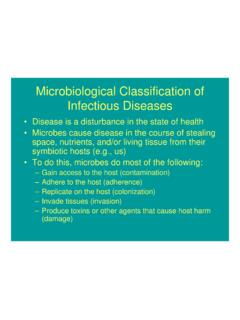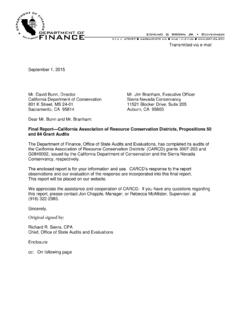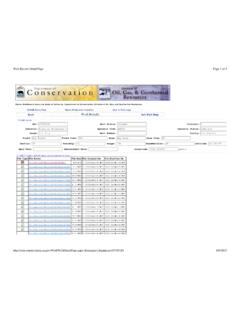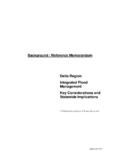Transcription of UCLA LACDPH Water Conservation HIA Final 28May2014
1 Public Health Impacts of Urban Water Conservation in california : Opportunities to Maximize Co-benefits and Minimize Harm With Case-Study Analysis of Water Conservation In the City of Burbank Final Report Prepared by the UCLA School of Public Health Health Impact Assessment Project in collaboration with The Los Angeles County department of Public Health This project is supported by a grant from the Health Impact Project, a collaboration of the Robert Wood Johnson Foundation and The Pew Charitable Trusts. May 2014 Urban Water Conservation HIA i May 28, 2014 UCLA HIA Project* Jonathan Fielding, , , , Principal Investigator Richard Jackson, , Co-Principal Investigator Brian Cole, , Project Manager, Co-Author Sharona Sokolow, , Research Associate, Co-Author Los Angeles County department of Public Health Jonathan Fielding, , , , Director of Public Health and Health Officer Paul Simon, MD, MPH Director, Division of Chronic Disease and Injury Prevention Steven Teutsch, MD, MPH, Chief Science Officer Contact Information: We welcome your questions and comments.
2 Please contact the Project Manager, Brian Cole, by email at or by phone at 310-206-1141. _____ *About the UCLA HIA Project Since 2001 the UCLA HIA Project has been working to advance the science and practice of health impact assessment in the Our multi-disciplinary team has conducted a wide range of health impact assessments on policies and projects, including HIAs of Living Wage laws, food and agriculture policies, education policies and transportation projects. Our work conducting HIAs, providing HIA training and technical assistance, and developing tools for HIA, including the HIA-CLIC website ( ) has been generous supported by the california Endowment, the CDC Foundation, the Partnership for Prevention, the Pew Charitable Trusts, the Public Health Foundation, the Robert Wood Johnson Foundation and the Health Impact Project, a collaboration of the Robert Wood Johnson Foundation and The Pew Charitable Trusts.
3 You can find more about our work on our project website at Urban Water Conservation HIA ii May 28, 2014 Technical Advisory Committee* * The authors wish to thank the members of the project s technical advisory committee for sharing their expertise and insights. Responsibility for this report s findings and recommendations and any errors is solely that of the authors Technical Advisory Committee Members Mike Antos, Council for Watershed Health Peter Brostrom, california department of Water Resources Chris Brown, california Urban Water Conservation Council Colleen Callahan, UCLA Luskin Center Edith de Guzman, TreePeople JR DeShazo, UCLA Luskin Center Conner Everts, Southern california Watershed Alliance Mike Hollis, Metropolitan Water District Caryn Mandelbaum, Environment Now Kenneth Murray, Los Angeles County department of Public Health Punkaj Parekh (late), Los Angeles department of Water and Power Milad Taghavi, Los Angeles department of Water and Power Tim Worley, American Waterworks Association The views expressed are those of the author(s) and do not necessarily reflect the views of The Pew Charitable Trusts or the Robert Wood Johnson Foundation.
4 Executive Summary (Statewide) Urban Water Conservation HIA ES1 1 May 28, 2014 Executive Summary (Statewide) Rationale Aim Policy Overview: california Senate Bill x7-7 20-by-2020 Scope of this health impact assessment Linkages with health Findings Recommendations Rationale In 2009 the california State Legislature passed Senate Bill 7x7 (SB X7-7 aka 20 by 2020 ). Part of a comprehensive suite of Water policies and infrastructure funding, SB X7-7 requires the state s Water suppliers to develop and implement plans to reduce urban Water usage by 20% by 2020. Urban Water suppliers are allowed to select the mix of Conservation measures that they deem best suited for meeting these targets. Their Conservation strategies are to be outlined in their in their Urban Water Management Plans (UWMPs) submitted to the state s department of Water Resources starting in 2010 with progress reports and updated plans to be submitted to the in 2015 and 2020.
5 Efforts to meet these targets may have unintended consequences for the health of Water users and their communities. Some health effects could be beneficial; some could be harmful; some could impact different populations differently. Assessment of the potential health effects of different Water Conservation options will provide decision-makers and community stakeholders with information that will help identify options to minimize harm and maximize potential health benefits while achieving Water Conservation goals and service mandates. Aim and scope This health impact assessment (HIA) aims to provide local decision-makers and community stakeholders with information on potential health-related impacts linked to different Water Conservation measures, particularly those being considered to meet the mandates of california s SB X7-7. According to Section 10631(g)(1) of the State Water Code, Water suppliers to consider health and other secondary effects of Water Conservation measures.
6 Information from this HIA can be used to help weigh the pros and cons of alternative Conservation options, develop Executive Summary (Statewide) Urban Water Conservation HIA ES1 2 May 28, 2014 mitigation measures to minimize potentially harmful effects, and identify strategies to maximize potential health benefits. This HIA starts with the premise that Water is a valuable resource for health. From this perspective, Water is not something to be rationed, but rather to be used wisely and efficiently. A second premise is that efforts to advance public health must focus on those who bear the greatest burden of ill health. Throughout this HIA, social equity concerns and reduction of health disparities will be raised repeatedly. Public health has long recognized that social and economic inequalities provide fertile ground for disease, disability and early death. Water Conservation efforts that seek to protect and promote the public s health need, at a minimum, to avoid exacerbating these inequalities, and better yet should seek to reduce them and provide protection against their effects.
7 The assessment is divided into two sections: (1) a general portion describing research on the linkages between specific Water Conservation options and health-related conditions, general estimates of the size and significance of effects, effects on vulnerable populations and descriptions of current conditions throughout the state, and (2) a case-study analysis of Water Conservation in the city of Burbank california . Water Conservation measures for achieving SB X7-7 targets Although SB X7-7 does not mandate how Water providers meet their Water use reduction targets, it does require that providers report on their implementation of fourteen demand management measures (DMMs) as part of their Urban Water Management Plans (UWMPs) submitted to the state every five years. Most utilities develop their Water Conservation programs around these fourteen DMMs. These DMMs are similar to the Best Management Practices (BMPs) developed by the california Urban Water Conservation Council (CUWCC), a voluntary organization of Water agencies and utilities.
8 In general, the state s DMMs are more specific and measurable than the CUWCC s BMPs (see Table ES1-1 below), making them more conducive for analysis in an HIA, since fewer assumptions are needed for the analysis. Executive Summary (Statewide) Urban Water Conservation HIA ES1 3 May 28, 2014 Demand Management Measures SB X7-7 (CA Water Code Section 10631) A. Water survey programs for single-family residential and multifamily residential customers B. Residential plumbing retrofit C. System Water audits, leak detection, and repair D. Metering with commodity rates for all new connections and retrofit of existing connections E. Large landscape Conservation programs and incentives (not addressed) F. High-efficiency washing machine rebate programs G. Public information programs (not addressed) H. School education programs (not addressed) I. Conservation programs for commercial, industrial, and institutional accounts J. Wholesale agency programs (not addressed) K.
9 Conservation pricing L. Water Conservation coordinator (not addressed) M. Water waste prohibition N. Residential ultra-low-flush toilet replacement programs Table ES1-1: Demand Management Measures (DMMs) for Urban Water Conservation listed in the california State Water Code. Urban Water uses are typically categorized as residential, commercial/industrial and institutional, with non-residential uses collectively referred to as CII uses. Residential use accounts for nearly half of urban Water use (Figure ES1-1). Among different residential Water end-uses, outdoor Water use comprises by far the largest share. Because these uses seem to offer the greatest potential for urban Water use reduction, the DMMs that address these uses are emphasized in the analysis. In addition to DMMs, which focus on reducing Water use among end-users, this HIA also examines expanded use of recycled Water to reduce use of potable Water but which does not necessarily reduce Water consumption overall.
10 Linkages between health and Water Conservation A systems view of the state s Water delivery system can help guide understanding of how Conservation measures might affect health. Key components flowing through this system are Water , money and energy (Figure ES1-2). The HIA follows the effects of Conservation measures on these components and how they in turn affect various health determinants and Summary (Statewide) Urban Water Conservation HIA ES1 4 May 28, 2014 Notes: Sector totals from the CA Dept. of Water Resources. State Water Plan: Update 2009. Data Summary: 1998-2005, Water balances (revised 03-10-11). Residential total and split of indoor residential uses from california Urban Water Plan 2013 Update and DeOreo et al., 2011. Analysis of Water Use in New Single Family Homes. Split of use by industry and commercial use from Gleick et al. 2003 cited in Pacific Institute 2012. Pacific Institute, 2012. Urban Water Demand in california to 2100: Incorporating Climate Change.

















